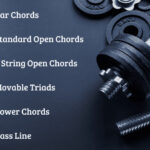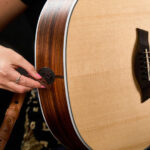Learning How To Play Reggae On Guitar opens up a world of rhythmic possibilities, whether you’re just beginning your musical journey or aiming to enhance your guitar skills. At guitarplayers.net, we’re dedicated to offering detailed lessons, evaluations, and a vibrant community to support your growth. This guide will help you master the essential techniques, rhythm patterns, and soloing approaches distinctive to reggae music.
1. What is Reggae Guitar and Why Learn It?
Reggae guitar is a style characterized by its distinctive “skank” rhythm, syncopated off-beats, and use of chord stabs. Learning reggae guitar not only introduces you to a fun and vibrant genre, but it also sharpens your rhythm, timing, and improvisation skills.
1.1. The Essence of Reggae Guitar
Reggae guitar focuses on rhythm and groove, often using clean tones and effects like chorus or delay. This creates a spacious, hypnotic sound that complements the message of peace, love, and social consciousness typical of reggae music.
1.2. Benefits of Learning Reggae Guitar
- Enhanced Rhythm: Reggae’s emphasis on off-beats improves your rhythmic precision.
- Versatile Skills: The techniques used in reggae, like chord voicings and muting, are transferable to other genres.
- Musicality: Learning reggae can deepen your understanding of music theory and improvisation.
- Cultural Appreciation: Exploring reggae connects you with its rich history and cultural impact.
2. Essential Techniques for Playing Reggae Guitar
Mastering reggae guitar involves a few key techniques that create its unique sound. These include the skank rhythm, muting, and specific chord voicings.
2.1. The Skank Rhythm: The Heart of Reggae
The “skank” rhythm is the foundation of reggae guitar. It involves playing short, percussive chords on the off-beats (the “2” and “4” in a 4/4 time signature). This creates the signature choppy, syncopated feel of reggae.
2.1.1. How to Play the Skank Rhythm
- Chord Voicings: Use major or minor barre chords, focusing on the higher strings.
- Strumming Pattern: Strum downwards on the off-beats, keeping your wrist loose.
- Muting: Immediately after strumming, lift your fingers slightly to mute the strings, creating a short, percussive sound.
- Practice: Start slowly, focusing on accuracy and consistency. Gradually increase the tempo as you become more comfortable.
Alt text: Guitarist demonstrating the reggae skank rhythm with muted chords on an electric guitar.
2.2. Muting Techniques
Muting is essential for creating the percussive sound of reggae guitar. There are two main muting techniques:
2.2.1. Finger Muting
Lift your fretting fingers slightly after strumming to dampen the strings. This technique requires precision and control to avoid unwanted ringing.
2.2.2. Palm Muting
Rest the edge of your strumming hand gently on the strings near the bridge. Adjust the pressure to control the amount of muting. Palm muting is useful for adding a subtle, sustained muting effect.
2.3. Chord Voicings and Progressions
Reggae often uses simple chord progressions with major and minor chords. Barre chords are common, but you can also use open chords with modified voicings.
2.3.1. Common Chord Progressions
- I-IV-V: A classic reggae progression (e.g., A-D-E).
- I-vi-IV-V: Adds a minor chord for a more melancholic feel (e.g., A-F#m-D-E).
- ii-V-I: A jazzy progression that works well in reggae (e.g., Bm-E-A).
2.3.2. Chord Voicing Tips
- Focus on Higher Strings: Emphasize the higher strings in your chords to create a bright, clear sound.
- Omit the Root: Try omitting the root note in some chords for a lighter, more syncopated feel.
- Add Extensions: Experiment with adding 7ths, 9ths, or 13ths to your chords for a richer sound.
3. Gear and Tone for Reggae Guitar
The right gear and tone can greatly enhance your reggae guitar playing. While you don’t need expensive equipment, choosing the right guitar, amp, and effects can make a significant difference.
3.1. Guitars for Reggae
- Electric Guitars: Fender Stratocasters and Telecasters are popular choices due to their bright, clear tone.
- Acoustic Guitars: Acoustic guitars with a bright, balanced tone work well for roots reggae and acoustic arrangements.
- Semi-Hollow Guitars: These guitars offer a warm, resonant tone that is suitable for various reggae styles.
3.2. Amplifiers
- Clean Amps: Choose an amplifier known for its clean headroom. Fender amps like the Twin Reverb or Deluxe Reverb are excellent choices.
- Solid-State Amps: Solid-state amps can provide a clean, consistent tone with reliable performance.
- Small Tube Amps: For home practice and recording, a small tube amp can offer a warm, responsive tone at lower volumes.
3.3. Effects Pedals
- Chorus: Adds a lush, shimmering effect that is common in reggae.
- Delay: Creates space and depth, enhancing the rhythmic feel.
- Reverb: Adds ambience, making the guitar sound fuller and more present.
- Compression: Evens out the dynamics, providing a consistent and punchy tone.
4. Reggae Guitar Rhythms: Beyond the Skank
While the skank is fundamental, reggae guitar also incorporates other rhythmic patterns. Exploring these variations can add depth and interest to your playing.
4.1. The One Drop
The “one drop” rhythm emphasizes the backbeat (beats 2 and 4) while omitting the first beat. This creates a strong, syncopated groove.
4.1.1. How to Play the One Drop
- Omit the First Beat: Don’t play a chord on the first beat of each measure.
- Emphasize Beats 2 and 4: Play the skank rhythm on beats 2 and 4.
- Listen and Feel: Internalize the groove by listening to reggae songs that use the one drop rhythm.
4.2. The Rockers Rhythm
The “rockers” rhythm is more driving and aggressive than the skank. It often involves playing a steady stream of eighth notes with a strong emphasis on the upbeats.
4.2.1. How to Play the Rockers Rhythm
- Eighth Notes: Strum eighth notes continuously, both downstrokes and upstrokes.
- Accent Upbeats: Emphasize the upbeats (the “and” counts) to create a driving feel.
- Muting: Use palm muting to control the sustain and add a percussive quality.
4.3. Hybrid Rhythms
Many reggae guitarists blend different rhythms to create unique and dynamic grooves. Experiment with combining the skank, one drop, and rockers rhythms to find your own style.
5. Reggae Guitar Soloing: Adding Your Voice
Reggae guitar solos often feature melodic lines, bluesy bends, and a focus on phrasing and space. Soloing in reggae allows you to express your musical personality while staying true to the genre’s vibe.
5.1. Scales and Modes for Reggae Soloing
- Minor Pentatonic Scale: A versatile scale that works well over minor chord progressions.
- Major Pentatonic Scale: Use this scale over major chord progressions for a brighter sound.
- Blues Scale: Adds a bluesy flavor with its characteristic flat 3rd, flat 5th, and flat 7th intervals.
- Mixolydian Mode: A major mode with a flat 7th, perfect for soloing over dominant chords.
5.2. Techniques for Reggae Soloing
- Bends: Use string bends to add emotion and expression.
- Slides: Slide between notes for a smooth, fluid sound.
- Hammer-Ons and Pull-Offs: Create legato phrases with hammer-ons and pull-offs.
- Double Stops: Play two notes simultaneously for a fuller, richer sound.
- Vibrato: Add vibrato to sustained notes to create warmth and depth.
5.3. Phrasing and Dynamics
- Space: Leave space in your solos to allow the rhythm to breathe.
- Call and Response: Create a musical dialogue between your guitar and the other instruments.
- Dynamics: Vary your volume and intensity to add interest and emotion.
- Melody: Focus on creating memorable melodic lines that complement the song.
6. Famous Reggae Guitarists to Study
Learning from the masters is an excellent way to improve your reggae guitar playing. Here are some influential reggae guitarists to study:
6.1. Ernest Ranglin
Known for his jazz-influenced style and innovative techniques, Ernest Ranglin is a pioneer of reggae guitar.
6.2. Al Anderson
As a member of Bob Marley and The Wailers, Al Anderson’s distinctive guitar work helped define the sound of reggae.
6.3. Junior Marvin
Another key guitarist for Bob Marley, Junior Marvin’s solos and rhythms are essential listening for any reggae guitarist.
6.4. Earl “Chinna” Smith
A prolific session guitarist, Earl “Chinna” Smith has played on countless reggae recordings and is known for his versatile style.
6.5. Cat Coore
As a founding member of Third World, Cat Coore’s guitar playing blends reggae with elements of jazz, funk, and rock.
7. How to Practice Reggae Guitar Effectively
Effective practice is crucial for mastering reggae guitar. Here are some tips to help you make the most of your practice time:
7.1. Set Goals
Set specific, measurable, achievable, relevant, and time-bound (SMART) goals for your practice sessions.
7.2. Warm-Up
Start with exercises to warm up your fingers and wrists, such as scales, arpeggios, and chord changes.
7.3. Focus on Rhythm
Spend time practicing the skank rhythm and other reggae rhythms with a metronome.
7.4. Learn Songs
Learn reggae songs by ear or using tabs. Pay attention to the guitar parts and try to emulate the original sound.
7.5. Record Yourself
Record your playing and listen back to identify areas for improvement.
7.6. Play with Others
Jam with other musicians to develop your timing, improvisation, and interaction skills.
8. Common Mistakes to Avoid When Learning Reggae Guitar
- Rushing the Rhythm: Reggae requires a relaxed, laid-back feel. Avoid rushing the tempo.
- Stiff Wrist: Keep your wrist loose and relaxed to avoid tension and fatigue.
- Ignoring Muting: Muting is essential for creating the percussive sound of reggae.
- Not Listening to Reggae: Immerse yourself in reggae music to internalize the rhythms, melodies, and feel.
- Neglecting Theory: Understanding music theory can help you create more interesting and sophisticated reggae guitar parts.
9. Reggae Guitar On guitarplayers.net
At guitarplayers.net, we are committed to providing resources for guitarists of all levels. Here’s how you can enhance your reggae guitar journey with us:
9.1. Lessons
Access a variety of reggae guitar lessons, from beginner basics to advanced techniques.
9.2. Reviews
Explore reviews of guitars, amplifiers, and effects pedals suitable for reggae music.
9.3. Sheet Music
Find sheet music and tablature for your favorite reggae songs.
9.4. Community
Connect with other reggae guitar enthusiasts in our community forum.
10. FAQ: Mastering Reggae Guitar
10.1. What is the most important element of reggae guitar playing?
Rhythm is paramount. The distinctive syncopation and off-beat emphasis define reggae’s feel.
10.2. Can I play reggae on any type of guitar?
Yes, but guitars with bright, clean tones like Stratocasters or Telecasters are ideal. Acoustic guitars also work well.
10.3. What effects are commonly used in reggae guitar?
Chorus, delay, reverb, and compression are popular choices for adding depth and character.
10.4. How can I improve my reggae rhythm playing?
Practice regularly with a metronome, focus on muting, and listen to a lot of reggae music.
10.5. What scales should I learn for reggae soloing?
Minor pentatonic, major pentatonic, blues scale, and Mixolydian mode are all useful for reggae solos.
10.6. How do I get that “skank” sound?
Play short, percussive chords on the off-beats and mute the strings immediately after strumming.
10.7. What’s the difference between the “skank” and the “one drop” rhythm?
The skank emphasizes the off-beats, while the one drop omits the first beat, creating a more syncopated feel.
10.8. Are there any famous reggae guitarists I should study?
Ernest Ranglin, Al Anderson, Junior Marvin, Earl “Chinna” Smith, and Cat Coore are all influential reggae guitarists.
10.9. How important is gear for playing reggae guitar?
While good gear can enhance your sound, it’s not essential. Focus on technique and feel first.
10.10. Where can I find resources for learning reggae guitar?
guitarplayers.net offers lessons, reviews, sheet music, and a community forum for reggae guitar enthusiasts.
Address: 1140 Boylston Street, Boston, MA 02215, United States. Phone: +1 (617) 747-2261. Website: guitarplayers.net.
Ready to start your reggae guitar journey? Visit guitarplayers.net today to discover lessons, find sheet music, read detailed reviews, and join our vibrant community of guitar players in the USA.


